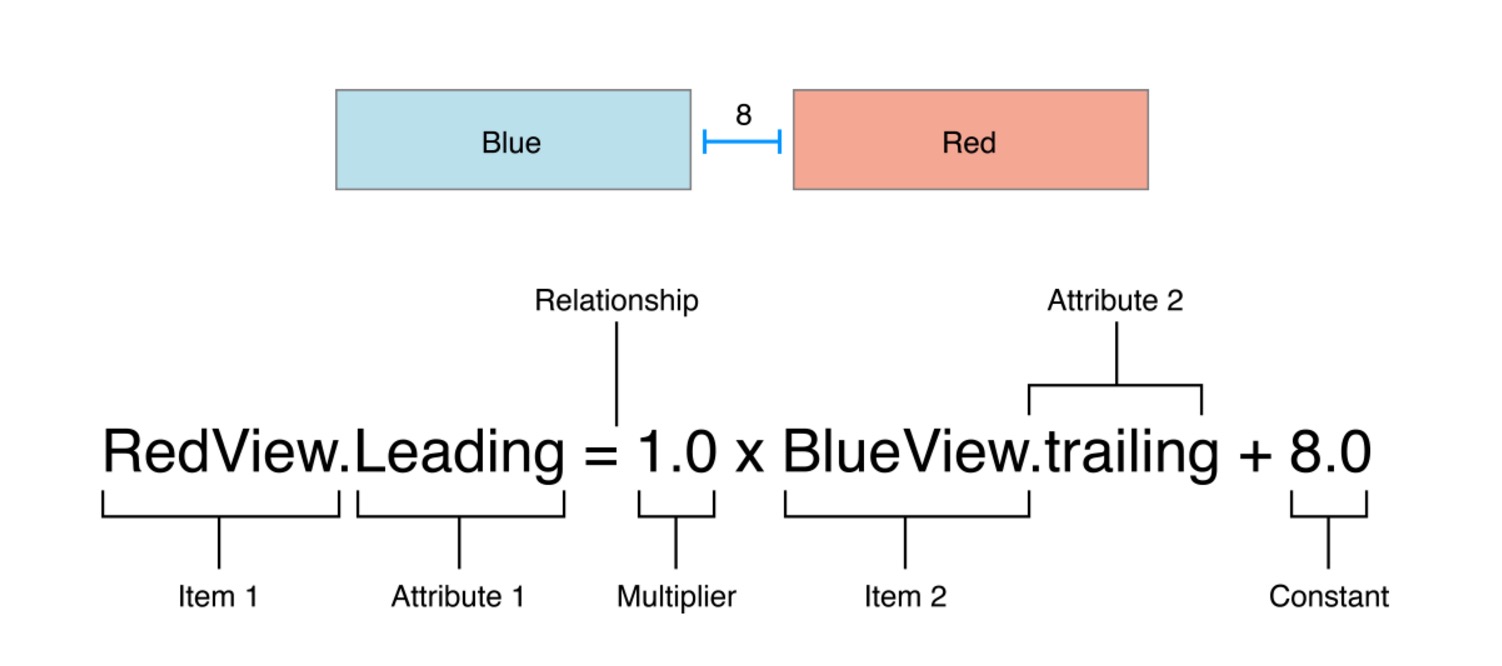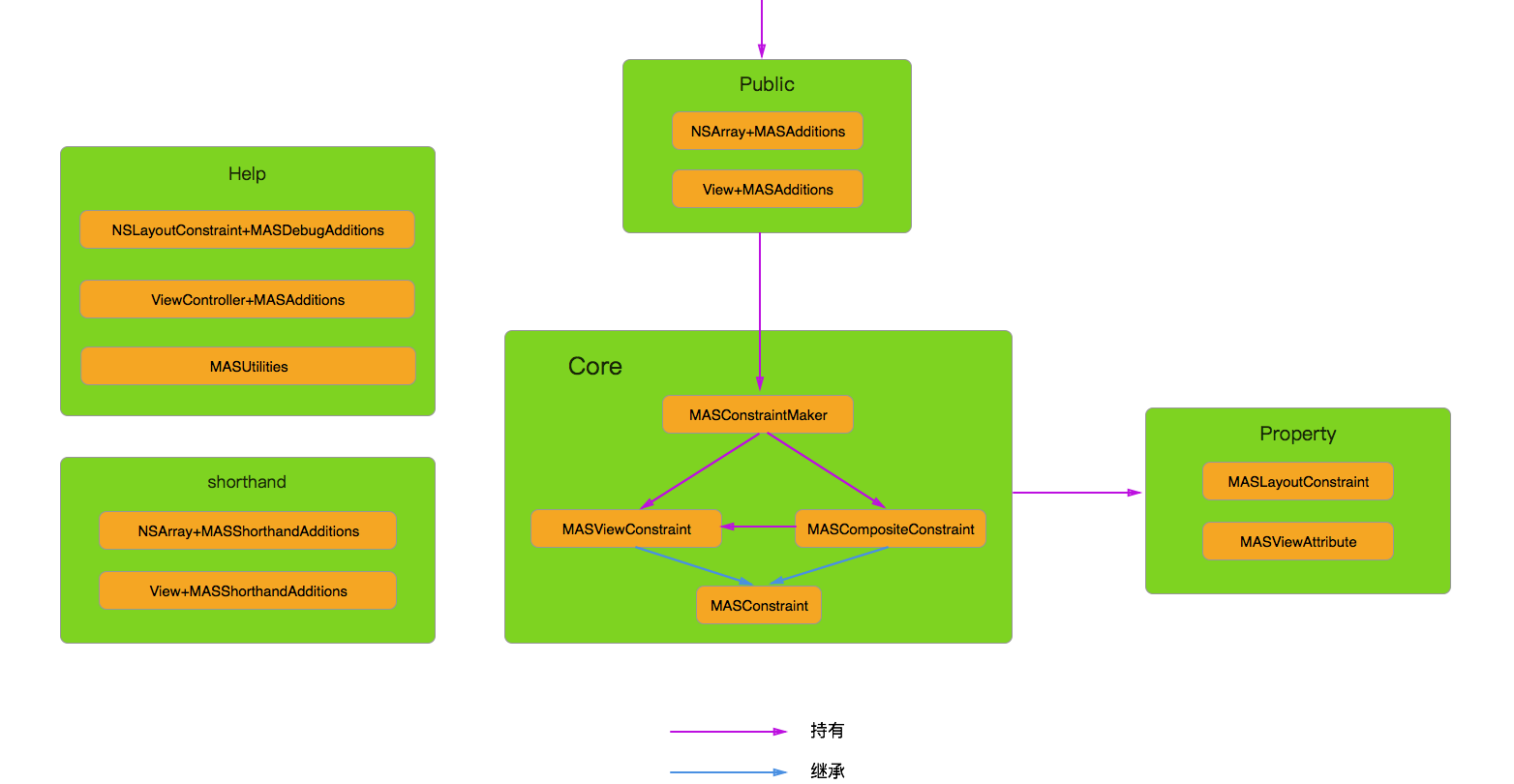追求Masonry
发布于 2016-01-21 02:27:49 | 140 次阅读 | 评论: 0 | 来源: 分享
Masonry jQuery布局插件
Masonry是一 个用来布局的jQuery插件
Autolayout就像一个知情达理,善解人意的好姑娘,可惜长相有点不堪入目,所以追求者寥寥无几。所幸遇到了化妆大师cloudkite,给她来了一个完美的化妆,从此丑小鸭Autolayout变成了美天鹅Masonry。前几日有幸一见,果然名不虚传,长相甜美,还善解人意。我果断放弃了Frame,开始追求Masonry。
初识Masonry
初见
我们先来看看Masonry到底有多美。
我要设置一个containView,他距离superView的上下左右边距都是10。 如果我用frame,应该是这样写的:
UIEdgeInsets edge = UIEdgeInsetsMake(10, 10, 10, 10);
CGSize superSize = view.superview.frame.size;
CGFloat width = superSize.width - edge.left - edge.right;
CGFloat heitht = superSize.height - edge.top - edge.bottom;
view.frame = CGRectMake(edge.left, edge.top, width, heitht);
逻辑比较复杂,阅读的时候还得想半天才能想明白,这个frame到底要表达的是什么意思。而且关键的是父View的大小如果改变,还需要再次重新设置Frame。看着Frame这黄脸婆,心里一阵别扭…
我们来看看充满青春活力的小鲜肉Masonry是怎么样的:
UIEdgeInsets edge = UIEdgeInsetsMake(10, 10, 10, 10);
[view mas_makeConstraints:^(MASConstraintMaker *make) {
make.edges.equalTo(view.superview).insets(edge);
}];
使用mas_makeConstraints在block中对View添加约束。view相对父View的边距为edge。
代码简单,逻辑一目了然。而且还能跟父View一起调整。简直是perfect,初见Masonry,惊为天人
细品
cloudkite给Autolayout披上一层漂亮的外衣之后,将其称为Masonry,但Masonry的本质还是Autolayout。
Autolayout是什么呢?Autolayout就是给View添加一堆约束,让View在布局的时候通过约束计算出Frame,然后进行布局(Autolayout更多内容见Autolayout的第一次亲密接触)。make.edges.equalTo(view.superview).insets(edge);就是添加约束的过程。
对于一个约束。他实际表示的是一个不等或者相等关系

用Masonry创建一个完整的约束应该是这样的
//view1的左边距离父View左边10个点:
[view1 mas_makeConstraints:^(MASConstraintMaker *make) {
make.left.equalTo(view1.superview.mas_left).multipliedBy(1).offset(10);
}];
对应到上图的表达式:
Item1: make MASConstraintMaker类型,view1的承载对象,表示View1Attribute: left 表示左边。left的make的属性。返回值为MASConstraint类型Relationship: equalTo 表示”=”。equalTo是MASConstraint的属性Item2: view1.superviewAttribute2: mas_left 同样表示左边,mas_left是Masonry给view加的属性,为了不重名,加了mas前缀Multiplier: multipliedBy(1) 系数为1Constant: offset(10) 常数为10
Attribute
MASConstraintMaker
上面的表达式中,我们可以看到,make是MASConstraintMaker类型。MASConstraintMaker给我们提供了22种Attribute类型
//Basic Attribute
@property (nonatomic, strong, readonly) MASConstraint *left;
@property (nonatomic, strong, readonly) MASConstraint *top;
@property (nonatomic, strong, readonly) MASConstraint *right;
@property (nonatomic, strong, readonly) MASConstraint *bottom;
@property (nonatomic, strong, readonly) MASConstraint *leading;
@property (nonatomic, strong, readonly) MASConstraint *trailing;
@property (nonatomic, strong, readonly) MASConstraint *width;
@property (nonatomic, strong, readonly) MASConstraint *height;
@property (nonatomic, strong, readonly) MASConstraint *centerX;
@property (nonatomic, strong, readonly) MASConstraint *centerY;
@property (nonatomic, strong, readonly) MASConstraint *baseline;
//Margin Attribute
@property (nonatomic, strong, readonly) MASConstraint *leftMargin;
@property (nonatomic, strong, readonly) MASConstraint *rightMargin;
@property (nonatomic, strong, readonly) MASConstraint *topMargin;
@property (nonatomic, strong, readonly) MASConstraint *bottomMargin;
@property (nonatomic, strong, readonly) MASConstraint *leadingMargin;
@property (nonatomic, strong, readonly) MASConstraint *trailingMargin;
@property (nonatomic, strong, readonly) MASConstraint *centerXWithinMargins;
@property (nonatomic, strong, readonly) MASConstraint *centerYWithinMargins;
//Convenient Attribute
@property (nonatomic, strong, readonly) MASConstraint *edges;
@property (nonatomic, strong, readonly) MASConstraint *size;
@property (nonatomic, strong, readonly) MASConstraint *center;
Attribute总体来说分为三大类
- Basic Attribute: 基本属性,支持到iOS6,一般使用得比较多
- Margin Attribute: 边缘相关属性,支持到iOS8。由于版本要求比较高,一般用得比较少。Margin相关的详细内容请参考iOS8上关于UIView的Margin新增了3个APIs
- Convenient Attribute: 便捷属性,为了使用方便而特意新增的属性。Autolayout本身没有对应的相关属性
Convenient Attribute实际是基本属性的组合。比如:edges表示left, right, top, bottom。
下面的两个代码实际的意义是一样的
//Convenient Attribute
make.edges.insets(edge);
//Basic Attribute
make.left.right.top.bottom.insets(edge);
MASConstraint
前面我们看到MASConstraintMaker中所有的Attribute都是MASConstraint类型。对于多个Attribute一起写的表达式:
make.left.right.top.bottom.insets(edge);
make.left返回的已经是MASConstraint类型,也就是说right这个Attribute是MASConstraint的属性。
MASConstraint给我们提供了19种Attribute:
//Basic Attribute
@property (nonatomic, strong, readonly) MASConstraint *left;
@property (nonatomic, strong, readonly) MASConstraint *top;
@property (nonatomic, strong, readonly) MASConstraint *right;
@property (nonatomic, strong, readonly) MASConstraint *bottom;
@property (nonatomic, strong, readonly) MASConstraint *leading;
@property (nonatomic, strong, readonly) MASConstraint *trailing;
@property (nonatomic, strong, readonly) MASConstraint *width;
@property (nonatomic, strong, readonly) MASConstraint *height;
@property (nonatomic, strong, readonly) MASConstraint *centerX;
@property (nonatomic, strong, readonly) MASConstraint *centerY;
@property (nonatomic, strong, readonly) MASConstraint *baseline;
//Margin Attribute
@property (nonatomic, strong, readonly) MASConstraint *leftMargin;
@property (nonatomic, strong, readonly) MASConstraint *rightMargin;
@property (nonatomic, strong, readonly) MASConstraint *topMargin;
@property (nonatomic, strong, readonly) MASConstraint *bottomMargin;
@property (nonatomic, strong, readonly) MASConstraint *leadingMargin;
@property (nonatomic, strong, readonly) MASConstraint *trailingMargin;
@property (nonatomic, strong, readonly) MASConstraint *centerXWithinMargins;
@property (nonatomic, strong, readonly) MASConstraint *centerYWithinMargins;
细看一下,MASConstraint中的Attribute和MASConstraintMaker完全一样。只是MASConstraintMaker中多了3种Convenient Attribute。
两者Attribute的一致,大大的提升了使用的方便性。使用过程中我们不用再去区分当前属性是MASConstraint还是MASConstraintMaker类型。(事实上没研究他的类型之前,我都不知道他们分别属于2种不同类的属性)
UIView(12月7日新增)
我们可以看到在.equalTo(view1.superview.mas_left)里面,superView也有Attribute。我们来看看UIView中有哪些Attribute:
// Basic Attribute
@property (nonatomic, strong, readonly) MASViewAttribute *mas_left;
@property (nonatomic, strong, readonly) MASViewAttribute *mas_top;
@property (nonatomic, strong, readonly) MASViewAttribute *mas_right;
@property (nonatomic, strong, readonly) MASViewAttribute *mas_bottom;
@property (nonatomic, strong, readonly) MASViewAttribute *mas_leading;
@property (nonatomic, strong, readonly) MASViewAttribute *mas_trailing;
@property (nonatomic, strong, readonly) MASViewAttribute *mas_width;
@property (nonatomic, strong, readonly) MASViewAttribute *mas_height;
@property (nonatomic, strong, readonly) MASViewAttribute *mas_centerX;
@property (nonatomic, strong, readonly) MASViewAttribute *mas_centerY;
@property (nonatomic, strong, readonly) MASViewAttribute *mas_baseline;
// Margin Attribute
@property (nonatomic, strong, readonly) MASViewAttribute *mas_leftMargin;
@property (nonatomic, strong, readonly) MASViewAttribute *mas_rightMargin;
@property (nonatomic, strong, readonly) MASViewAttribute *mas_topMargin;
@property (nonatomic, strong, readonly) MASViewAttribute *mas_bottomMargin;
@property (nonatomic, strong, readonly) MASViewAttribute *mas_leadingMargin;
@property (nonatomic, strong, readonly) MASViewAttribute *mas_trailingMargin;
@property (nonatomic, strong, readonly) MASViewAttribute *mas_centerXWithinMargins;
@property (nonatomic, strong, readonly) MASViewAttribute *mas_centerYWithinMargins;
可以看出,在UIView中的Attribute和MASConstraint中的几乎一模一样,只是每一个Attribute加了一个mas_前缀。
由于UIView是系统的类,对其扩展属性和方法一般都需要添加自己的前缀,避免跟原有属性和方法冲突。不过他们的意义跟MASConstraint中的Attribute是相同的
Relationship
约束表示的是2个item之间的关系,在Autolayout中一共定义了3种关系:=, >=, <=,对应到Masonry中:
- (MASConstraint * (^)(id attr))equalTo;
- (MASConstraint * (^)(id attr))greaterThanOrEqualTo;
- (MASConstraint * (^)(id attr))lessThanOrEqualTo;
相等关系我们一般用的多。那么不相等关系我们什么时候用呢?
假如我有一个Label。Label的长度不能超出父View,如果label中的文字比较短,我希望是文字有多长,Label就有多长。
由于label具有IntrinsicContentSize属性。所以默认情况下,他是文字有多长,Label就有多长。(更多IntrinsicContentSize的内容参见Autolayout的第一次亲密接触)。所以我们只需要设置Label的长度小于父View即可
[label mas_makeConstraints:^(MASConstraintMaker *make) {
make.left.offset(0);
make.centerY.offset(0);
make.width.lessThanOrEqualTo(label.superview);
}];
multiplier
multiplier表示Attribute前面的乘数。Masonry提供了2种添加multiplier的方法
// Sets the NSLayoutConstraint multiplier property
- (MASConstraint * (^)(CGFloat multiplier))multipliedBy;
// Sets the NSLayoutConstraint multiplier to 1.0/dividedBy
- (MASConstraint * (^)(CGFloat divider))dividedBy;
multipliedBy: 直接设置乘数dividedBy: 设置乘数的倒数 multiplier = 1.0/dividedBy 一般宽或者高的约束使用multiplier比较多
Constant
Masonry提供了4种设置constant的方法
//Modifies the NSLayoutConstraint constant,only affects MASConstraints in which the first item's NSLayoutAttribute is one of the following NSLayoutAttributeTop, NSLayoutAttributeLeft, NSLayoutAttributeBottom, NSLayoutAttributeRight
- (MASConstraint * (^)(MASEdgeInsets insets))insets;
//Modifies the NSLayoutConstraint constant,only affects MASConstraints in which the first item's NSLayoutAttribute is one of the following NSLayoutAttributeWidth, NSLayoutAttributeHeight
- (MASConstraint * (^)(CGSize offset))sizeOffset;
//Modifies the NSLayoutConstraint constant, only affects MASConstraints in which the first item's NSLayoutAttribute is one of the following NSLayoutAttributeCenterX, NSLayoutAttributeCenterY
- (MASConstraint * (^)(CGPoint offset))centerOffset;
//Modifies the NSLayoutConstraint constant
- (MASConstraint * (^)(CGFloat offset))offset;
insets: 用来设置left, right, top, bottom。接受MASEdgeInsets类型值sizeOffset: 用来设置width, height。接受CGSize类型的值centerOffset: 用来设置centerX, centerY。接受CGPoint类型的值offset: 可以用来设置所有的东西。接受CGFloat类型的值
其实一般情况下,我只使用offset….
小技巧
- 如果等式2边的Attribute是一样的,我们可以省略等式右边的Attribute
- 如果是等于关系,并且右边的view是父View。连equalTo也可以省略
- 如果equalTo里面传的是NSValue类型,效果跟设置offset是一样的
- 如果offset为0,其实也是可以省略的…
下面所有代码实际效果是一样的:
// 完整的
make.left.equalTo(view1.superview.mas_left).offset(0);
//省略Attribute的
make.left.equalTo(view1.superview).offset(0);
//省略equalTo的
make.left.offset(0);
//使用equalTo替代offset的
make.left.equalTo(@0);
//终极大招,省略所有的... 可惜会有warning
make.left;
不过对于make.left,编译器会报一个警告:你用getter方法获取回来的值未使用,所以不应该使用”.”语法

对于这个警告我们可以将返回值转为空消除:
(void)make.left;
不过终究又变得麻烦了,又要多写6个字母,愁人…
设置或更新约束
对于约束的设置,Masonry提供了3种方法,分别为设置约束、更新约束、重写设置约束
// 设置约束
- (NSArray *)mas_makeConstraints:(void(^)(MASConstraintMaker *make))block;
// 更新约束
- (NSArray *)mas_updateConstraints:(void(^)(MASConstraintMaker *make))block;
// 重新设置约束
- (NSArray *)mas_remakeConstraints:(void(^)(MASConstraintMaker *make))block;
mas_makeConstraints: 初次设置约束使用。mas_updateConstraints: 更新约束时使用。如果找不着这条约束,会新增,相当于mas_makeConstraints。mas_remakeConstraints: 重新设置约束。先将view上所有约束移除,再新增约束
注意:mas_updateConstraints只能更新已有约束。如果第一次使用的是left, right设置的相对宽度。更新的时候想换成使用width。不能使用mas_updateConstraints,因为已有约束里面没有width的约束,新增width之后会跟原有left, right约束冲突。此时应该使用mas_remakeConstraints
批量设置约束
假设有View1,view2,view3三个View,我们想要他们的宽高都等于CGSizeMake(100, 50)。我们可以对他们进行批量设置:
NSValue *sizeValue = [NSValue valueWithCGSize:CGSizeMake(100, 50)];
[@[view1,view2,view3] mas_makeConstraints:^(MASConstraintMaker *make) {
make.size.equalTo(sizeValue);
}];
由于我们还要设置view的top,left等位置约束。那可不可以在设置位置的mas_makeConstraints里面批量设置宽高呢?实际是可以的!
//advance set
[view1 mas_makeConstraints:^(MASConstraintMaker *make) {
(void)make.top.left;
make.size.equalTo(@[view2,view3,sizeValue]);
}];
不过需要注意的是。设置约束的时候,view一定是已经被addSubview的(详情参考Autolayout的第一次亲密接触),否则会抛异常。所以我们一般在最后一个view上加批量约束
Priority
我们知道约束是有优先级的,Masonry给我们提供了4个设置优先级的接口:
// Sets the NSLayoutConstraint priority to a float or MASLayoutPriority
- (MASConstraint * (^)(MASLayoutPriority priority))priority;
// Sets the NSLayoutConstraint priority to MASLayoutPriorityLow
- (MASConstraint * (^)())priorityLow;
// Sets the NSLayoutConstraint priority to MASLayoutPriorityMedium
- (MASConstraint * (^)())priorityMedium;
// Sets the NSLayoutConstraint priority to MASLayoutPriorityHigh
- (MASConstraint * (^)())priorityHigh;
priority: 可以设置任意的优先级,接受的参数是0-1000的数字priorityLow: 设置低优先级,优先级为250priorityMedium: 设置中优先级,优先级为500priorityHigh: 设置高优先级,优先级为750
需要注意的是,使用priorityLow、priorityMedium、priorityHigh的时候。不是.priorityHigh,而是.priorityHigh()
key
当约束冲突发生的时候,我们经常为找不到是哪个View冲突的而烦恼,这一堆View是个什么东西呀?
"<MASLayoutConstraint:0x7f8de483fb10 UIView:0x7f8de2f53870.left == UIView:0x7f8de2f586c0.left>",
"<MASLayoutConstraint:0x7f8de4818b50 UIView:0x7f8de2f53870.right == UIView:0x7f8de2f586c0.right>",
"<MASLayoutConstraint:0x7f8de4818870 UIView:0x7f8de2f53870.width == 100>",
"<NSLayoutConstraint:0x7f8de4847e90 UIView:0x7f8de2f586c0.width == 375>"
Will attempt to recover by breaking constraint
<MASLayoutConstraint:0x7f8de4818870 UIView:0x7f8de2f53870.width == 100>
这时候我们可以设置View的key:
self.view.mas_key = @"self.view";
view1.mas_key = @"view1";
设置之后再看一下,哈哈,现在好多了。可以清晰的知道是哪个view了
"<MASLayoutConstraint:0x7fcd98d17c40 UIView:view1.left == UIView:self.view.left>",
"<MASLayoutConstraint:0x7fcd98d2b2c0 UIView:view1.right == UIView:self.view.right>",
"<MASLayoutConstraint:0x7fcd98d2adb0 UIView:view1.width == 100>",
"<NSLayoutConstraint:0x7fcd98e42050 UIView:self.view.width == 375>"
Will attempt to recover by breaking constraint
<MASLayoutConstraint:0x7fcd98d2adb0 UIView:view1.width == 100>
大家可能会觉得这样一个一个设置,多麻烦啊!别着急,Masonry提供了批量设置的宏MASAttachKeys 只需要一句代码即可全部设置:
MASAttachKeys(self.view,view1);
Shorthand(12月7日新增)
在写代码的时候,可能你会感觉有的东西要加mas前缀,有的东西又不用加,代码风格不统一,而且加mas前缀还麻烦。
前面介绍过加mas前缀主要是在扩展系统类的时候为了避免与原有类冲突,这是Apple推荐的做法。不过目前来说,即使不加mas前缀,也不会有什么问题。所以Masonry提供了不加mas_前缀的方法,只需要你定义几个宏即可。
1. MAS_SHORTHAND
定义MASSHORTHAND宏之后。可以使用UIView,NSArray中不带mas前缀的makeConstraints,updateConstraints,remakeConstraints。以及UIView中不带mas_前缀的Attribute。
2. MAS_SHORTHAND_GLOBALS
默认的equalTo方法只接受id类型的对象。有时候我们想传入一个CGFloat, CGSize, UIEdgeInsets等。还需要将其转化成NSValue对象,比较麻烦。Masonry也考虑到了这种情况。只需要定义MAS_SHORTHAND_GLOBALS宏。就可以直接对equalTo传入基础类型。Masonry自动转化成NSValue对象
拨开Masonry的衣服
Masonry的基本使用方法介绍完了,那么我们来看看Masonry的内部到底有些什么东西?
结构
Masonry一共有十三个类,我将这13个类分为5个模块: 
Help
Help模块主要是一些辅助的类。
NSLayoutConstraint+MASDebugAdditions:这个类的主要作用是重写NSLayoutConstraint的description函数。让约束发生冲突的时候,更易读。如果View或者constraint设置了Key,直接用key的值显示到description中。如果没有设置,显示View或者constraint的指针。
ViewController+MASAdditions:提供了ViewController的LayoutGuide相关属性,以便View对齐时使用 MASUtilities:定义了一些公用的宏和属性
Shorthand
对于系统原有类(NSArray,UIView)的扩展。Masonry的category方法和属性都加有mas前缀。这也是Apple建议的做法,避免跟系统原有方法冲突。但是有时候我们可能想用的更方便,不想写mas前缀(没办法,我就是这么懒…)
在NSArray+MASShorthandAdditions和View+MASShorthandAdditions中定义了不带mas前缀的扩展。这些扩展根据你是否定义了MAS_SHORTHAND宏来确定是否编译。所以你只需要定义MAS_SHORTHAND宏,就可以方便的使用不带mas前缀的方法,比如:-[view makeConstraints:]
Public
Public模块主要是对外暴露的方法。使用者使用Masonry可以直接接触到。
NSArray+MASAdditions:主要有定义和更新约束的方法,如mas_makeConstraints:View+MASAdditions:除了定义和更新约束的一系列方法之外,还为View增加了mas_top, mas_left等Attribute属性
Core
Core模块就是Masonry的核心部分,Masonry的大部分功能都在这4个类里实现
MASConstraintMaker:约束控制器。控制更新,删除,或者新增约束MASConstraint:约束的基类,虚类。定义了Constraint的基本属性和方法。MASViewConstraint: 约束的主要实现类。所有对约束使用的功能均在此类中完成MASCompositeConstraint:约束的集合类。内部有一个数组,可以保存多个MASViewConstraint。对MASCompositeConstraint调用方法实际等于对其内部的所有MASViewConstraint调用方法
Property
此模块主要封装了一些MASConstraint持有的属性。为了使用更方便,或者扩展功能
MASViewAttribute:每一个Attribute都有一个View与之对应,为了使用更方便,所以将他们通过一个类封装在一起MASLayoutConstraint:默认的NSLayoutConstraint是没有Key这个属性的,为了Debug方便。派生一个子类,持有key属性
实现
当我们给View添加一个约束的时候到底发生了什么?
[view1 mas_makeConstraints:^(MASConstraintMaker *make) {
make.left.top.equalTo(view1.superview).offset(20);
}];
我们首先来看make.left.top.equalTo(view1.superview).offset(20);
一、执行”make.left”
MASConstraintMaker类中有一个属性constraints专门用来存储constraint
@property (nonatomic, strong) NSMutableArray *constraints;
当执行make.left的时候, 会将相应的MASConstraint添加到constraints数组中
- (MASConstraint *)left {
return [self addConstraintWithLayoutAttribute:NSLayoutAttributeLeft];
}
- (MASConstraint *)addConstraintWithLayoutAttribute:(NSLayoutAttribute)layoutAttribute {
return [self constraint:nil addConstraintWithLayoutAttribute:layoutAttribute];
}
//核心方法
- (MASConstraint *)constraint:(MASConstraint *)constraint addConstraintWithLayoutAttribute:(NSLayoutAttribute)layoutAttribute {
MASViewAttribute *viewAttribute = [[MASViewAttribute alloc] initWithView:self.view layoutAttribute:layoutAttribute];
MASViewConstraint *newConstraint = [[MASViewConstraint alloc] initWithFirstViewAttribute:viewAttribute];
//调用make.left.top时走入这里将原来的ViewConstraint替换成MASCompositeConstraint
if ([constraint isKindOfClass:MASViewConstraint.class]) {
//replace with composite constraint
NSArray *children = @[constraint, newConstraint];
MASCompositeConstraint *compositeConstraint = [[MASCompositeConstraint alloc] initWithChildren:children];
compositeConstraint.delegate = self;
[self constraint:constraint shouldBeReplacedWithConstraint:compositeConstraint];
return compositeConstraint;
}
// 调用make.left的时候走入这里,将constraint加入到self.constraints中
if (!constraint) {
newConstraint.delegate = self;
[self.constraints addObject:newConstraint];
}
return newConstraint;
}
对MASConstraintMaker调用Attribute的get方法,最终都会走到-constraint:addConstraintWithLayoutAttribute:中,在这个方法中,通过对应的Attribute生成MASViewConstraint。然后将MASViewConstraint加入到constraints中
二、执行”.top”
make.left返回的是MASConstraint类型。所以make.left.top是对MASViewConstraint类型调用top方法。
- (MASConstraint *)top {
return [self addConstraintWithLayoutAttribute:NSLayoutAttributeTop];
}
- (MASConstraint *)addConstraintWithLayoutAttribute:(NSLayoutAttribute)layoutAttribute {
NSAssert(!self.hasLayoutRelation, @"Attributes should be chained before defining the constraint relation");
return [self.delegate constraint:self addConstraintWithLayoutAttribute:layoutAttribute];
}
当执行-addConstraintWithLayoutAttribute的时候,ViewConstraint通过delegate又调回到MASConstraintMaker的-constraint:addConstraintWithLayoutAttribute:中。
在MASConstraintMaker的-constraint:addConstraintWithLayoutAttribute:里,将原来constraints中的MASViewConstraint替换成MASCompositeConstraint。MASCompositeConstraint持有top,left 2个属性。对MASCompositeConstraint做操作时候,其内部的所有属性都会执行相应的操作
三、执行”.equalTo(view1.superview)”
- (MASConstraint * (^)(id))equalTo {
return ^id(id attribute) {
return self.equalToWithRelation(attribute, NSLayoutRelationEqual);
};
}
- (MASConstraint * (^)(id, NSLayoutRelation))equalToWithRelation {
return ^id(id attribute, NSLayoutRelation relation) {
if ([attribute isKindOfClass:NSArray.class]) {
NSAssert(!self.hasLayoutRelation, @"Redefinition of constraint relation");
NSMutableArray *children = NSMutableArray.new;
for (id attr in attribute) {
MASViewConstraint *viewConstraint = [self copy];
viewConstraint.secondViewAttribute = attr;
[children addObject:viewConstraint];
}
MASCompositeConstraint *compositeConstraint = [[MASCompositeConstraint alloc] initWithChildren:children];
compositeConstraint.delegate = self.delegate;
[self.delegate constraint:self shouldBeReplacedWithConstraint:compositeConstraint];
return compositeConstraint;
} else {
NSAssert(!self.hasLayoutRelation || self.layoutRelation == relation && [attribute isKindOfClass:NSValue.class], @"Redefinition of constraint relation");
self.layoutRelation = relation;
self.secondViewAttribute = attribute;
return self;
}
};
}
当执行Relationship的方法时,都会走到-equalToWithRelation中。 在这个方法里面主要是给realationship和secondViewAttribute赋值:
1. 如果不是数组
直接对realationship和secondViewAttribute赋值
2. 如果是数组
如: .equalTo(@[view1.mas_left,view2.mas_left]),逻辑上肯定不能是不等关系(>=,<=),所以realationship不用赋值,使用默认值(=)。copy出多个viewConstraint,将secondViewAttribute赋值。然后用多个viewConstraint组成的compositeConstraint替换调原来的viewConstraint。
四、执行”.offset(10)”
- (MASConstraint * (^)(CGFloat))offset {
return ^id(CGFloat offset){
self.offset = offset;
return self;
};
}
- (void)setOffset:(CGFloat)offset {
self.layoutConstant = offset;
}
offset(10)会将10传入到ViewConstraint中,用layoutConstant属性将其存起来。(offset主要影响的是约束里面的constant)
五、mas_makeConstraints
看完了make.left.top.equalTo(view1.superview).offset(20);,我们再看看mas_makeConstraints中到底做了什么?
- (NSArray *)mas_makeConstraints:(void(^)(MASConstraintMaker *))block {
self.translatesAutoresizingMaskIntoConstraints = NO;
MASConstraintMaker *constraintMaker = [[MASConstraintMaker alloc] initWithView:self];
block(constraintMaker);
return [constraintMaker install];
}
mas_makeConstraints方法很简单
- 将self.translatesAutoresizingMaskIntoConstraints至为NO。translatesAutoresizingMaskIntoConstraints表示是否将设置的Frame转化为约束。当自己设置约束的时候需要将其置为NO
- 创建出MASConstraintMaker对象
- 通过block抛出到外面设值
- constraintMaker install
上面的代码我们知道,关键的地方还是在于constraintMaker install
六、constraintMaker install
- (NSArray *)install {
if (self.removeExisting) {
NSArray *installedConstraints = [MASViewConstraint installedConstraintsForView:self.view];
for (MASConstraint *constraint in installedConstraints) {
[constraint uninstall];
}
}
NSArray *constraints = self.constraints.copy;
for (MASConstraint *constraint in constraints) {
constraint.updateExisting = self.updateExisting;
[constraint install];
}
[self.constraints removeAllObjects];
return constraints;
}
- 如果需要removeExisting,就把已有的约束remove掉,当调用mas_remakeConstraints的时候会将removeExisting值置为YES
- 遍历constraints,调用[constraint install]
- 清空constraints,这里的constraintMaker只是一个零时属性,只是一个工具类,不需要存储。所以用完之后就可以将constraints清空
其实真正关键的地方在[constraint install]
七、constraint install
- (void)install {
// 1. 已经installed的将不做任何操作
if (self.hasBeenInstalled) {
return;
}
//2. 从ViewAttribute中剥离出item和attribute
MAS_VIEW *firstLayoutItem = self.firstViewAttribute.item;
NSLayoutAttribute firstLayoutAttribute = self.firstViewAttribute.layoutAttribute;
MAS_VIEW *secondLayoutItem = self.secondViewAttribute.item;
NSLayoutAttribute secondLayoutAttribute = self.secondViewAttribute.layoutAttribute;
//3. 如果没有secondViewAttribute,默认secondItem为其父View,secontAttribute等于firstLayoutAttribute。
if (!self.firstViewAttribute.isSizeAttribute && !self.secondViewAttribute) {
secondLayoutItem = self.firstViewAttribute.view.superview;
secondLayoutAttribute = firstLayoutAttribute;
}
//4. 创建真正用于Autolayout的约束layoutConstraint
MASLayoutConstraint *layoutConstraint
= [MASLayoutConstraint constraintWithItem:firstLayoutItem
attribute:firstLayoutAttribute
relatedBy:self.layoutRelation
toItem:secondLayoutItem
attribute:secondLayoutAttribute
multiplier:self.layoutMultiplier
constant:self.layoutConstant];
//5. 将priority和key赋值
layoutConstraint.priority = self.layoutPriority;
layoutConstraint.mas_key = self.mas_key;
//6. 找到要添加约束的installView
if (self.secondViewAttribute.view) {
MAS_VIEW *closestCommonSuperview = [self.firstViewAttribute.view mas_closestCommonSuperview:self.secondViewAttribute.view];
NSAssert(closestCommonSuperview,
@"couldn't find a common superview for %@ and %@",
self.firstViewAttribute.view, self.secondViewAttribute.view);
self.installedView = closestCommonSuperview;
} else if (self.firstViewAttribute.isSizeAttribute) {
self.installedView = self.firstViewAttribute.view;
} else {
self.installedView = self.firstViewAttribute.view.superview;
}
//7. 添加或更新约束
MASLayoutConstraint *existingConstraint = nil;
if (self.updateExisting) {
existingConstraint = [self layoutConstraintSimilarTo:layoutConstraint];
}
if (existingConstraint) {
// just update the constant
existingConstraint.constant = layoutConstraint.constant;
self.layoutConstraint = existingConstraint;
} else {
[self.installedView addConstraint:layoutConstraint];
self.layoutConstraint = layoutConstraint;
[firstLayoutItem.mas_installedConstraints addObject:self];
}
}
- 如果已经installed就不做任何操作
- 从ViewAttribute中剥离出item和attribute。前面我们介绍过MASViewAttribute的类主要是将item和attribute2个属性封装在了一起。
- secondViewAttribute的值来自于
.equalTo(item.attribute)中的item.attribute。当我们写下类似make.left.offset(10);约束的时候,是没有secondViewAttribute的,这时候默认secondItem为其父View,secontAttribute等于firstLayoutAttribute。这就解释了为什么可以这样写make.left.offset(10); - 创建真正用于Autolayout的约束layoutConstraint
- 将priority和key赋值
- 找到要添加约束的installView。如果是2个View之间的约束,需要寻找这2个View最接近的共同父View。添加约束
- 添加或更新约束。当调用mas_updateConstraints的时候updateExisting=YES。这时候会查找是否有已经存在的约束。有就更新,没有就添加。如果是mas_makeConstraints或mas_remakeConstraints,则直接添加
Extension
仅仅将代码结构和基本实现过程解析了一下,更多实现细节还需要大家自己去阅读源码
说实话,Masonry的代码写得真漂亮,不管是代码格式规范,还是设计模式。看起来简直是一种享受。建议大家阅读。